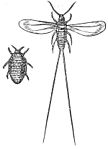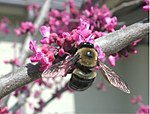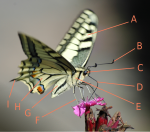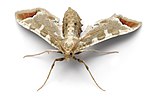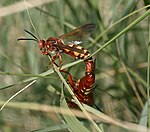| This Wikipedia page has been superseded by Portal:Insects and is retained primarily for historical reference. |
| Note: Article entries are now being transcluded directly on the main portal page. However, this page should be retained for historical reference. |
| This page is an archive of the articles that have been selected to appear on Portal:Insects. |
Earwigs make up the insect order Dermaptera, found throughout the Americas, Eurasia and Australia. It is one of the smaller insect orders, with only 1,800 recorded species in 12 families. Typical earwigs have characteristic cerci, a pair of forceps-like pincers on their abdomen, and membranous wings folded underneath short forewings, hence the scientific name for the order, which translates literally as "skin wings". Earwig fossils have been found dating back 208 million years, but are now included in the extinct suborder Archidermaptera dating back to the Late Triassic. Many orders of insect have been suggested as the closest relatives of earwigs; Grylloblattaria is the most likely.
Earwigs are nocturnal; they often hide in small, moist crevices during the day, and are active at night, feeding on a wide variety of insects and plants. Damage to foliage, flowers, and various crops are commonly blamed on earwigs, especially the common earwig Forficula auricularia. However, the harmfulness of earwigs to foliage is still under debate, as they also eat certain insects that damage them. Earwigs rarely fly, even though they are capable of flight. Earwigs undergo an average of 5 moults over the course of a year before they become adults. Many earwig species display maternal care, which is uncommon among insects. Female earwigs are for their eggs, and will continue to watch over the nymphs until their second moult. Sexual dimorphism – including differences in pincer shape – arise in later moults.
Ants are social insects of the family Formicidae, belonging to the order Hymenoptera. They are easily identified by their elbowed antennae and a distinctive node-like structure that forms a slender waist. Ants evolved from wasp-like ancestors in the mid-Cretaceous period 130 to 110 million years ago, and diversified after the rise of flowering plants. More than 12,500 of the estimated 22,000 species have been classified.
Ants have colonised almost every landmass on Earth. The only places lacking indigenous ants are Antarctica and certain remote or inhospitable islands. Ants thrive in most ecosystems, and may form 15%–25% of the terrestrial animal biomass. Their success has been attributed to their social organisation and their ability to modify habitats, tap resources, and defend themselves.
Ants form colonies that range in size from a few dozen predatory individuals living in small natural cavities to highly organised colonies which may occupy large territories and consist of millions of individuals. These larger colonies consist mostly of sterile wingless females forming castes of "workers", "soldiers", or other specialised groups. Nearly all ant colonies also have some fertile males called "drones" and one or more fertile females called "queens". The colonies are sometimes described as superorganisms because the ants appear to operate as a unified entity, collectively working together to support the colony.
Aphids, also known as plant lice (and in Britain as greenflies), are small plant-eating insects, and members of the superfamily Aphidoidea. Aphids are among the most destructive insect pests on cultivated plants in temperate regions. About 4,400 species of 10 families are known, varying in length from 1 to 10 mm (0.04 to 0.4 in). Around 250 species are serious pests for agriculture and forestry as well as an annoyance for gardeners. Natural enemies include predatory lady beetles (Coleoptera: Coccinellidae), hoverfly larvae (Diptera: Syrphidae), parasitic wasps, aphid midge larvae, crab spiders, lacewings (Neuroptera: Chrysopidae), and entomopathogenic fungi like Lecanicillium lecanii and the Entomophthorales.
Aphids are distributed worldwide, but are most common in temperate zones. Also, in contrast to many taxa, species diversity is much lower in the tropics than in the temperate zones. They can migrate great distances, mainly through passive dispersal by riding on winds. For example, the currant lettuce aphid (Nasonovia ribisnigri) is believed to have spread from New Zealand to Tasmania in this way. Aphids have also been spread by human transportation of infested plant materials. Aphids are the only animals known to synthesise carotenoids, an ability they gained by coopting the synthetic genes from fungi.
Cochineal is the name of both a crimson or carmine dye and of the cochineal insect (Dactylopius coccus), a scale insect in the suborder Sternorrhyncha, from which the dye is derived. There are other species in the genus Dactylopius which can be used to produce cochineal extract, but they are difficult to distinguish from D. coccus. The primary biological distinctions between species are minor differences in host plant preferences, in addition to very different geographic distributions. D. coccus itself is native to tropical and subtropical South America and Mexico.
This type of insect, a primarily sessile parasite, lives on cacti from the genus Opuntia, feeding on moisture and nutrients in the cacti. The insect produces carminic acid which deters predation by other insects. Carminic acid can be extracted from the insect's body and eggs to make the dye. Cochineal is primarily used as a food colouring and for cosmetics.
The effects suffered by bees from toxic chemicals that they encounter in the environment can be severe. These chemicals include various man-made compounds, such as insecticides and fertilizers, as well as a variety of naturally-occurring chemicals from plants, such as ethanol resulting from the fermentation of organic material. Intoxication in bees can result from exposure to ethanol from fermented nectar, ripe fruits, and man-made and natural chemicals in the environment.
The effects of alcohol on bees are sufficiently similar to the effects of alcohol on humans that honey bees have been used as models of human ethanol intoxication. However, the metabolism of bees and humans is sufficiently different that bees can safely collect nectar from plants that contain compounds toxic to humans. The honey produced by bees from these toxic nectars can be poisonous if consumed by humans. Many humans have eaten toxic honey and become quite ill as a result. Natural processes can also introduce toxic substances into nontoxic honey produced from nontoxic nectar. Microorganisms in honey can convert some of the sugars in honey to the toxic compound ethanol. This process of ethanol fermentation is intentionally harnessed to produce the alcoholic beverage mead from fermented honey.
Chrysiridia rhipheus, the Madagascan sunset moth or simply sunset moth, is a day-flying moth of the Uraniidae family. It is considered to be one of the most impressive and beautiful Lepidoptera, though the iridescent parts of the wings appear coloured through optical interference rather than pigments. Adult moths have a wingspan of 7–9 centimetres (2.8–3.5 in). It is endemic to Madagascar, where it is found throughout the year in most parts of the island, with peak populations between March and August.
Females lay about 80 eggs under the leaves of Omphalea spp. The caterpillars are whitish-yellow with black spots and red feet and are covered in club-ended black setae. Silk spun from the mouth helps the caterpillars hold on to smooth leaves and climb back to the plant when they fall. After completing four instars, the caterpillars spin an open network cocoon. The pupal stage lasts from 17 to 23 days. Chrysiridia rhipheus is the sole specialist herbivore of the four species of Omphalea in Madagascar. Omphalea is toxic: the toxins are sequestered by the feeding caterpillar and retained in the pupal and adult stages. Thousands of these moths migrate between the eastern and western ranges of their host plants.
The Lulworth Skipper, Thymelicus acteon, is a butterfly of the Hesperiidae family. Its name is derived from Lulworth Cove in the county of Dorset, where the first specimens in Great Britain were collected in 1832 by English naturalist James Charles Dale.
The species occurs locally across Central Europe, Asia Minor and North Africa, where its population is considered stable. Its numbers have declined in Northern Europe, leading to its European status of 'vulnerable'. Its range in Britain is restricted to the south coast of Dorset, however it is locally abundant and its numbers currently are perhaps at their greatest since its discovery there.
With a wingspan of 24–28 millimetres (0.9–1.1 in), females being larger than males, the Lulworth Skipper is a small butterfly, the smallest member of the Thymelicus genus in Europe and among the smallest butterflies in Britain. Aside from the size difference, the sexes are distinguished by females having a distinct circle of golden marks on each forewing. Due to their likeness to the rays around the eye of a peacock's feather, these are often known as 'sun-ray' markings, and they can faintly appear on males.
The external morphology of Lepidoptera is the physiological structure of the bodies of insects belonging to the order Lepidoptera, also known as butterflies and moths. Lepidoptera are distinguished from other orders principally by the presence of scales on the external parts of the body and appendages, especially the wings. Butterflies and moths vary in size from microlepidoptera only a few millimetres long, to conspicuous animals with a wingspan of many inches, such as the Monarch butterfly and Atlas moth.
The larvae – caterpillars – have a toughened (sclerotised) head capsule, chewing mouthparts, and a soft body, that may have hair-like or other projections, 3 pairs of true legs, and up to 5 pairs of prolegs.
Adults have a hardened exoskeleton, except for the abdomen which is less sclerotised. Their mouthparts include a prominent proboscis formed from maxillary galeae, and are adapted for sucking nectar. They have two immobile, multi-faceted compound eyes, and only two simple eyes or ocelli. Antennae are prominent and besides the faculty of smell, act as olfactory radar, and also aid navigation, orientation and balance during flight.
Lepidoptera is a large order of insects, comprising an estimated 174,250 species in 126 families and 46 superfamilies. It is one of the most widely-recognisable insect orders in the world, encompassing moths and the three superfamilies of butterflies, skippers, and moth-butterflies.
The term "Lepidoptera" was coined by Carl Linnaeus in 1735 and is derived from the Ancient Greek words λεπίδος (scale) and πτερόν (wing). Lepidopteran species are characterised by more than 20 derived features, some of the most apparent being the scales covering their bodies and wings, and a proboscis. The scales are modified, flattened "hairs", and give butterflies and moths their extraordinary variety of colours and patterns. Butterflies and moths are holometabolous, meaning they undergo complete metamorphosis. Mating and the laying of eggs are normally carried out on or near the larval host plants. The larvae are commonly called caterpillars, and are markedly different from their adult moth or butterfly form, having a cylindrical body with a well developed head, mandible mouthparts, and 0–11 (usually 8) pairs of prolegs.
Sphecius grandis, also called the western cicada killer, is a colony-forming species of wasp in the genus Sphecius (cicada killer wasps). It shares the same nesting biology as its congener the eastern cicada killer, S. speciosus. S. grandis, like all other species in the genus, mainly provides cicadas for their offspring. It is colonial, mating brooding once a year, in July and early August. Adults are typically 3–5 cm (1.2–2.0 in) long, and amber-yellow with yellow rings on the abdomen.
Members of the genus Sphecius are not habitually aggressive and save their venom for cicadas which they paralyse and take back to their nests. The female catches around four or more cicadas for provisioning, places them in her brood cells and then proceeds to lay eggs in her cells. The species is endemic to Central America and the Western United States, and is found at a higher mean altitude than other species of Sphecius. The males emerge earlier than females, but generally die after only a couple of days.



